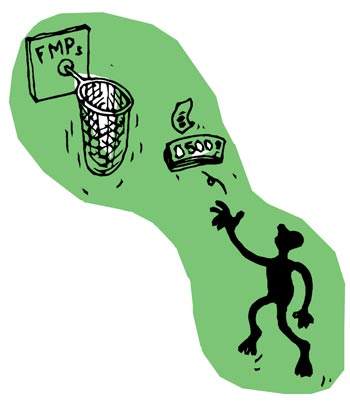
Those who invest in fixed income securities such as bank fixed deposits (FDs) and small savings schemes are constantly looking out for new alternatives that will provide better post-tax returns without significantly compromising on security.
One alternative that they can definitely consider are fixed maturity plans or FMPs offered by mutual funds that typically mature in around one to 36 months.
Sometimes FMPs are also called FTPs or fixed term plans.
The monies collected under such schemes are typically invested in debt products like commercial papers (CPs), corporate debentures, certificate of deposit (CDs), bonds, government securities and even bank deposits.
Typically the investment is in paper that has a minimum security rating (normally not less than AA) that is mentioned in the offer document and hence the safety of the money is reasonably ensured.
Click NEXT to read how FMPs improve your post-tax returns
With inputs from Abhishek Kumar Singh, AVP (Research), Apnapaisa.com.
 Apnapaisa is a price comparison engine that allows consumers in India the ability to compare the EMI, interest rates and other fees for home loans, car loans, personal loans, business loans, credit cards, compare online quotes and features of life insurance, health insurance, car insurance, travel insurance and other general insurance policies in India.
Apnapaisa is a price comparison engine that allows consumers in India the ability to compare the EMI, interest rates and other fees for home loans, car loans, personal loans, business loans, credit cards, compare online quotes and features of life insurance, health insurance, car insurance, travel insurance and other general insurance policies in India.

How these plans can improve your post-tax returns?
The reasons are mentioned below...
Even if the fund was to invest in bank fixed deposit it gets a much better rate as they are able to place a bulk deposit. As an individual you cannot get such interest rates from the banks.
Also FMPs have fund managers and the bulk funds to get much better yields from the debt market than you have as an individual.
Add the fact that mutual fund structure is very tax efficient for such plans. Typically they do not declare any dividends and are redeemed only on maturity that is longer than a year.
Thus the interest earned by the fund is returned as appreciation in the value of the units to you.
Since the units are held for more than 12 months these are considered as long-term capital assets and you pay tax at a maximum rate of 10 per cent (or 20 per cent after indexation if that is more beneficial for you).
Click NEXT to understand this concept with the help of an illustration.

Here is an example to illustrate the point:
If you have Rs 50,000 to invest for around 12 months (and one day) you will at the most get around 8 per cent per annum from a good bank which means your deposit of Rs 50,000 will give you a return of Rs 4,000.
If you are a taxpayer your net post-tax return will work out to Rs 2,764, Rs 3,176 or Rs 3,588 if your marginal tax rate is 30.9 per cent, 20.6 per cent or 10.3 per cent respectively.
Now if you put it in an FMP and the fund house accumulates the savings of many investors like you and invests it back in the same bank or in other equally safe instruments for a period that matches the tenure of the fund (12 months and 1 day in our example) they are likely to be able to get a return of 8.5 per cent which means they will make a return of around Rs 4,250 on your money post tax.
Even after reducing the fund management charge of around 0.25 per cent the return left will still be higher at Rs 4,125, which is still higher than if you had invested on your own.
Click NEXT to read the complete illustration.

The real value of course comes from the tax treatment.
Since this will be taxed as a long-term capital gain the maximum tax you will pay is at 10.3 per cent which means the post-tax return in this example will be Rs 3,700 which is higher for all categories of tax payers than what they could have managed on their own.
The actual tax liability could be even less if the indexation benefit is high but since that is a complicated exercise we will ignore the possible benefits from that exercise.
Even in the dividend option where they declare dividends the fund pays a dividend distribution tax of 12.875 per cent for individuals and the dividends are not thereafter taxable in the hands of the recipients.
Thus if you pay a higher rate of tax even the dividend option can be beneficial to you.
This is one of the main reasons why these plans are so popular.
Click NEXT to read what factors you must consider when you decide to invest in FMPs.

What factors should you consider before you invest in such plans?
FMPs are open for a short period only, so the choice available to you of plans to invest in is limited by the plans that are currently being offered.
The good news is that new FMPs are continuously being floated and you are likely to be able to get one from your favourite fund house within a reasonably short period.
The bad news is that the distributors make little or no money in distributing these plans and hence you will either need to invest directly with the fund house or may have to pay a fee to your distributor to invest in such funds.
As on November 13, 2010 the following plans are available.

Click NEXT to read other important factors to consider before investing in FMPs

Your money is locked in for the duration of fund and once the money is invested, then you have to compulsorily remain invested for the entire term of the fund. Of course some funds list the units on the stock exchange and that can give you the ability to sell off the units and retrieve your money in the case of need.
Such listed FMPs that have more than 12 months to mature also provide a good opportunity to invest in existing FMPs that have invested well.
The fund manager chooses instruments with similar maturity as the FMP.
For example, if the FMP is for a period of 18 months, then he chooses the instruments that have a maturity of 18 months.
By applying this tactics, the fund manager somewhere reduces the fluctuation in price caused by interest rate scenario. This also brings down the overall cost of the portfolio, as once the instruments are bought there is no significant churning of the portfolio.
Unlike when you invest directly there are no guaranteed returns.
So who can drive significant benefits from a FMP investment?
Any investor who wants to invest in fixed income securities such as bank fixed deposit, small savings etc. is a reasonable sized investor and has taxable income in excess of Rs 5,00,000 per year.